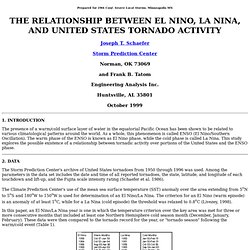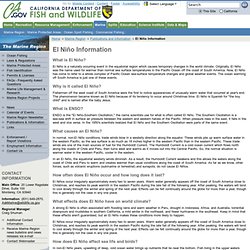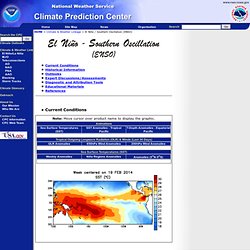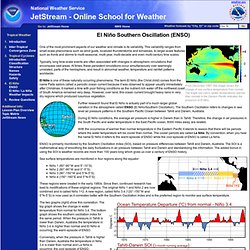

ENSO Blog. PMEL/TAO El Nino: Forecasts. El Niño Southern Oscillation FAQ. MJOs and the Onset of ENSO. The public has become increasingly aware of climate variations particularly with variations in the El Nino- Southern Oscillation (ENSO), which exhibits year-to-year fluctuations and climate change with variations in time-scales of decades or longer.

Scientists are now recognizing that atmospheric fluctuations on time-scales of days to weeks may influence the evolution of these longer time-scales processes. In particular, recent research suggested that short time-scale variations of convection in the tropical oceans (referred to as the "Madden-Julian Oscillation" or MJO) may contribute to year-to-year variations in the tropical Pacific and may help trigger the development and demise of El Niño. Interest in this possibility has increased recently because the 1997-98 El Niño, arguably the strongest of the century, followed exceptionally strong MJO activity during the winter of 1996-97.
NOAA La Niña Page. Schaefer/Tatom El Nino & tornadoes paper (19th SLSC) Prepared for 19th Conf.

Severe Local Storms, Minneapolis MN Joseph T. Schaefer Storm Prediction Center Norman, OK 73069 and Frank B. Engineering Analysis Inc. Huntsville, AL 35801 October 1999 The presence of a warm/cold surface layer of water in the equatorial Pacific Ocean has been shown to be related to various climatological patterns around the world. The Storm Prediction Center's archive of United States tornadoes from 1950 through 1996 was used. The Climate Prediction Center's use of the mean sea surface temperature (SST) anomaly over the area extending from 5oN to 5oS and 180oW to 150oW is used for determination of an El Nino/La Nina. In this paper, an El Nino/La Nina year is one in which the temperature criterion over the key area was met for three or more consecutive months that included at least one Northern Hemisphere cold season month (December, January, February).
El Niño and its Effect on the Southeast U.S. In the central and eastern Pacific, there is a lot of year-to-year variability.

Some years are much warmer and wetter (El Niño), and some years are much cooler and drier (La Niña). El Niño Information. What is El Niño?

El Niño is a naturally occurring event in the equatorial region which causes temporary changes in the world climate. Originally, El Niño was the name used for warmer than normal sea surface temperatures in the Pacific Ocean off the coast of South America. Now, El Niño has come to refer to a whole complex of Pacific Ocean sea-surface temperature changes and global weather events. The ocean warming off South America is just one of these events. NOAA El Niño: Research, Forecasts and Observations. El Ni o/Southern Oscillation (ENSO) Technical Discussion. ENSO – What is it? El Niño and the Southern Oscillation, also known as ENSO is a periodic fluctuation in sea surface temperature (El Niño) and the air pressure of the overlying atmosphere (Southern Oscillation) across the equatorial Pacific Ocean.
El Niño is so termed because it generally reaches full strength toward the end of the year, and early Christian inhabitants of western equatorial South America equated the warm water current and the resulting impacts with their holiday celebrating the birth of Jesus (known as El Niño (Literally, El Niño translates to "The Boy Child" and is a reference to Jesus as a baby.) in Spanish). The Southern Oscillation describes a bimodal (Having two peaks (or modes).) variation in sea level barometric pressure (The force exerted by the atmosphere at sea level (zero meters elevation) as measured by a barometer.) as measured by a barometer.) between observation stations at Darwin, Australia and Tahiti. Additional Information. El Niño/La Niña Home. Climate Prediction Center -
CPC - Climate Weather Linkage: El Niño Southern Oscillation. Barnston, A.G., C.

F. Ropelewski, 1992: Prediction of ENSO episodes using canonical correlation analysis. J. Climate, 5, 1316-1345. Barnston, A.G., M. Barnston, A. Halpert, M. Higgins, R.W., Y. Higgins, R. Hoerling, M. Hoerling, M. Hoerling, M. Hoerling, M. Climate Prediction Center: ENSO Diagnostic Discussion.
Climate Prediction Center: ENSO Diagnostic Discussion. El Niño Southern Oscillation (ENSO) From December 1997, this image shows the change of sea surface temperature from normal.

The bright red colors (water temperatures warmer than normal) in the Eastern Pacific indicates the presence of El Niño. One of the most prominent aspects of our weather and climate is its variability. This variability ranges from small-scale phenomena such as wind gusts, localized thunderstorms and tornadoes, to larger-scale features such as fronts and storms to multi-seasonal, multi-year, multi-decade and even multi-century time scales. Typically, long time-scale events are often associated with changes in atmospheric circulations that encompass vast areas.
At times, these persistent circulations occur simultaneously over seemingly unrelated, parts of the hemisphere, and result in abnormal weather, temperature and rainfall patterns worldwide. ENSO Information. El Niño Theme Page: distributed information on El Niño. NOAA El Niño: Research, Forecasts and Observations. La Niña Frequently Asked Questions. Www.pmel.noaa.gov/tao/proj_over/pubs/ElNinoLaNina.pdf.